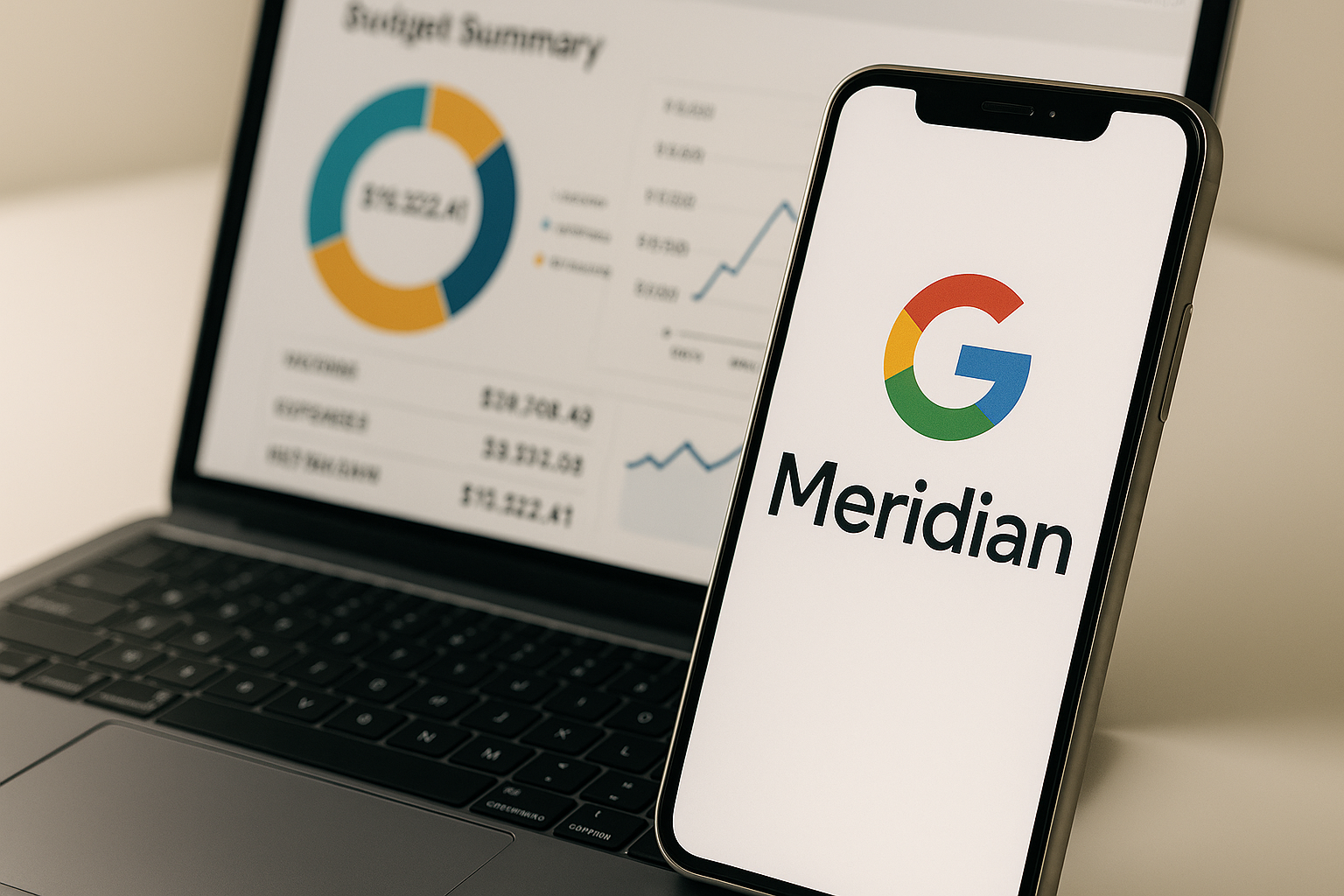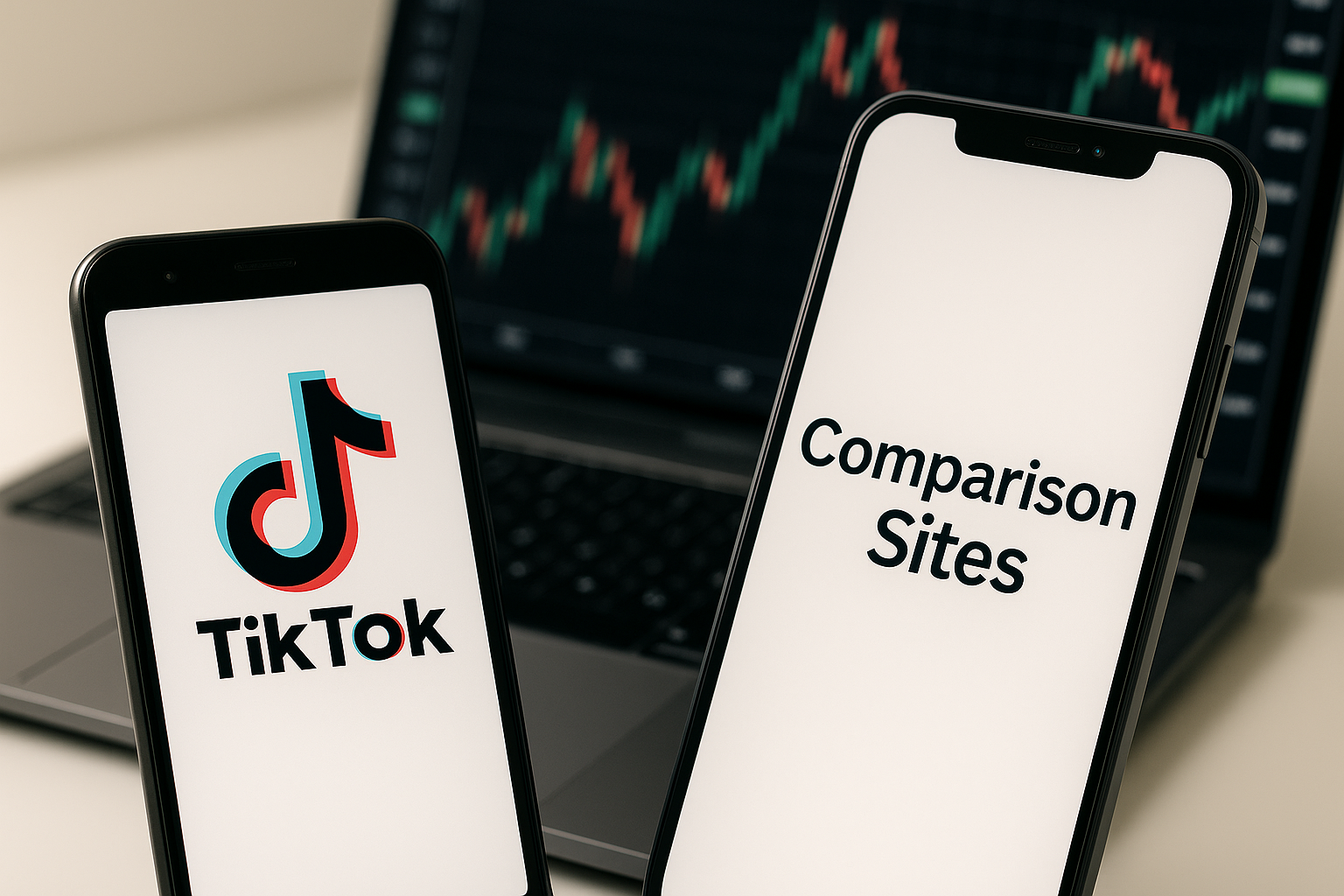Marketing tips, news and more
Explore expert-backed articles on SEO, data, AI, and performance marketing. From strategic trends to hands-on tips, our blog delivers everything you need to grow smarter.

Data-Driven Budget Management with Google Meridian Integration
As digital marketing investments keep growing, brands want proof that every dollar actually drives outcomes. It’s no longer enough to ask “which channel got more clicks?”—the real question is: which channel contributed most to sales, revenue lift, or brand equity? This is where data-driven budget management comes in. Google’s open-source solution, Google Meridian, was built for this shift—moving decisions from intuition to analytics. With Meridian you can measure marketing spend, optimize budgets, and see channel-level ROI with clarity. What is Google Meridian?Google Meridian is a Marketing Mix Modeling (MMM) tool designed to quantify the impact of marketing investments. Unlike user-level measurement (e.g., cookies), Meridian operates on aggregate data, making it privacy-resilient and cookie-independent. It analyzes historical marketing activity to estimate each channel’s contribution to sales and revenue, then produces an actionable roadmap for channel reallocation. Budgeting shifts from guesswork to measurable strategy.Why Data-Driven Budgeting MattersEach channel influences the conversion journey differently. TV may build reach and mental availability; digital channels can trigger intent and purchase. Measuring their combined, interacting effects is hard without robust modeling. Data-driven budgeting resolves this complexity with statistical rigor. True ROI measurement: Quantifies the incremental return of every channel. Channel interaction analysis: Reveals synergies across TV, Social, Search, Influencer, etc. Forward scenarios: Answers “What if we increase Social by 20%?” with concrete projections. Strategic allocation: Shifts budget toward the most efficient marginal returns. Backed by tools like Google Meridian, data-driven budgeting delivers higher performance and lower wasted spend through smarter, evidence-based campaigns.Google Meridian Integration: Step-by-Step1) Data PreparationModel quality depends on data quality. Start by consolidating clean, complete datasets: Channel-level spend, impressions, clicks, and conversions. External factors (weather, seasonality, promos, competition, macroeconomy). Load data into Google BigQuery (or an equivalent data warehouse). 2) ModelingMeridian uses a Bayesian modeling approach to learn from historical patterns and estimate each channel’s incremental effect on sales. It produces ROI response curves (diminishing returns) that visualize saturation points—making it obvious where additional spend still pays off and where it doesn’t.3) Budget OptimizationOnce the model is calibrated, Meridian proposes budget plans under different constraints: Fixed-budget scenario: Keep total spend constant; optimize cross-channel allocation. Flexible-budget scenario: Vary total spend to maximize overall ROI. This answers the classic question: “Where should I spend the next dollar?”4) Monitoring & RefreshMMM is not one-and-done. As market conditions, campaign tactics, and consumer behavior evolve, refresh the model with new data and iterate allocations. This continuous loop sustains performance gains over time.Strategic Tips for the Türkiye Market Include local seasonality: holidays, mega-sale periods, back-to-school windows. Jointly model TV + Digital where linear & CTV still matter for reach. Continuously validate data completeness and fix gaps early. Align Marketing, Finance, and Analytics around a shared data culture and taxonomy. ConclusionData-driven budget management is a competitive edge in modern marketing. Google Meridian operationalizes this edge with open-source, privacy-resilient MMM. Implemented correctly, it clarifies how much to invest in each channel and when. Beyond explaining the past, Meridian simulates smart future budget scenarios. It’s time to decide with data—not hunches. Optimize spend, lift ROI, and see the true value of every ad investment.FAQDoes Meridian require user-level data?No. Meridian works on aggregated signals, so it’s resilient to cookie restrictions and privacy changes.How often should we refresh the model?Typically quarterly, or after major market shifts, significant promotions, or large channel strategy changes.Can Meridian handle offline media like TV or OOH?Yes. MMM naturally incorporates offline and online channels alongside external factors (seasonality, macro, competition).What do “diminishing returns” and “saturation” mean here?They describe how incremental ROI falls as spend increases beyond the efficient range for a channel—Meridian’s response curves visualize this.

Data-Driven Black Friday: Strategies and Tools That Boost Sales
Data-driven Black Friday strategies have become the key to increasing e-commerce sales. Instead of focusing solely on discounts, success now depends on understanding user behavior and using the right tools. With this approach, brands can better track the customer journey, create personalized campaigns, and gain a competitive advantage. Planning supported by accurate data maximizes both revenue and customer satisfaction.📌 The Importance of a Data-Driven Approach on Black FridayDuring Black Friday, brands often try to stand out with high discounts. However, today discounts alone are not enough. E-commerce shoppers consider many factors when making purchasing decisions—such as product variety, user experience, stock management, delivery speed, and secure payment options. Therefore, it is critical for brands to understand their customers’ shopping habits.For instance, according to a Google study, shopping-related search interest in the MENA region increases by 36% year over year during this period. This shows that Black Friday has evolved from a discount season into a highly competitive marketplace that requires strategic management. Data-driven content and advertising strategies are now among the main factors influencing purchase decisions.Moreover, a data-focused approach makes it easier to identify which products are preferred by which demographic groups. For example, users aged 18–24 tend to look for electronics and accessories, while those aged 30–40 are more likely to search for deals in home textiles and decor. Such segmentation analyses ensure the ad budget is directed to the right audience—potentially leading to up to 20% higher conversion rates.🔍 Analyzing E-Commerce Shopping BehaviorOne of the most critical steps in increasing sales during Black Friday is analyzing shopping behavior. Data such as which pages users spend the most time on, which products they add to their cart but do not purchase, or which ad campaigns drive the most clicks are highly valuable. Tools like Google Analytics or GA4 can help visualize the conversion gap between “add to cart” and “purchase.” This gap typically ranges from 30% to 40%, and closing it through accurate analysis can significantly increase sales.Additionally, heatmap tools (such as Hotjar or Microsoft Clarity) help identify which areas of a webpage receive the most clicks. For example, if 70% of users interact with the review section on a product page, adding more visual reviews or user videos can accelerate purchasing decisions. This way, you not only read behavioral data but also enhance user experience to drive more sales.📊 Data Sources for Black Friday SalesFor a successful Black Friday campaign, relying on a single data source is not sufficient. Brands must evaluate both on-site and off-site data together. On-site data includes traffic and conversion analytics from Google Analytics or GA4, customer behavior tracked through CRM systems, and product movement data from inventory management systems. These insights make it easier to determine which products attract more attention, which customer segments make repeat purchases, and where users abandon their carts.Off-site data, on the other hand, is valuable for identifying market trends and positioning against competitors. For example, Google Trends can reveal seasonal increases in search interest for specific product categories. Social media engagement metrics show which campaigns resonate most with consumers, while competitor pricing tools help identify the general market price range. Combining all these data sources not only drives short-term sales growth but also lays the groundwork for long-term customer loyalty.🎯 Personalized Black Friday CampaignsOne of the most effective ways to achieve success during Black Friday is through personalization. When customer data—such as past purchases, browsing history, and product interests—is analyzed correctly, brands can offer tailored deals. For example, sending a targeted email with discounts on sneakers to a user who viewed that category in the past month can increase the purchase likelihood by up to 40%. Similarly, sending a coupon code to users who abandoned their carts can recover a significant portion of lost sales.Personalization should not be limited to emails or SMS campaigns. Dynamic ad models can retarget users with products they previously viewed on social media or the Google Display Network. Additionally, AI-powered recommendation engines can analyze user preferences and suggest the most relevant products based on past behavior.💡 Managing Advertising Budgets EffectivelyAd budgets can deplete quickly during Black Friday due to intense competition. Therefore, managing budgets with a data-driven approach is essential. Historical campaign data show that cost-per-click (CPC) can increase by up to 60% on Black Friday itself. Brands that are unprepared for this surge may exhaust their budgets early in the day. Instead, distributing the budget evenly through hourly or daily caps ensures a more balanced approach.Channel-based performance comparisons are also crucial. Google Ads, Meta, TikTok, and programmatic channels may deliver different conversion rates. If Shopping Ads on Google achieve a 5% conversion rate, but Meta Ads remain at 2%, prioritizing the higher-performing channel makes more sense. Furthermore, allocating a separate budget for remarketing campaigns is highly effective in converting warm audiences into customers.🤝 Post-Black Friday Customer LoyaltyBlack Friday is not just an opportunity for short-term sales growth—it’s also a crucial period for building long-term customer relationships. Many brands treat customers acquired during this time as one-time buyers and fail to re-engage them. However, maintaining communication after the campaign is key to turning them into loyal customers.For instance, sending a “thank you” email to customers who purchased during Black Friday, along with a discount code for future orders, can increase repeat purchases by up to 30%. Loyalty programs are also effective during this stage. Offering reward points for purchases over a certain amount encourages customers to return for future campaigns. Additionally, maintaining social media interaction with exclusive content strengthens the emotional connection between the brand and its audience. Post-Black Friday communication strategies ensure sustainable long-term revenue for brands.Black Friday can be highly profitable when guided by the right strategies and data-driven decisions. However, success depends not only on discount rates but also on understanding user behavior and taking the right actions at the right time. If you want to develop more effective strategies and adopt a data-driven approach for this Black Friday, feel free to contact us! ✨📩Frequently Asked Questions (FAQ)What is a data-driven Black Friday strategy?A data-driven Black Friday strategy is one that relies not only on discounts but also on user behavior, traffic sources, search trends, and historical sales data. With this approach, brands can identify which products are in high demand, which channels drive better conversions, and which customer segments are most profitable—allowing them to allocate budgets more efficiently.Which data sources play the most critical role during Black Friday?Google Analytics/GA4, CRM data, Google Trends, and competitor pricing tools are the most widely used sources during this period. For example, you can analyze the “add to cart – purchase” gap in GA4, track rising product categories using Google Trends, and plan campaigns for repeat buyers using CRM insights.How should customer data be evaluated after Black Friday?Data collected during the campaign should not only measure sales performance but also help build long-term loyalty. For instance, customers who made purchases during the campaign can be enrolled in loyalty programs, and personalized emails can be sent to increase repeat purchases. This way, Black Friday transforms from a one-time sales event into a foundation for lasting customer relationships.

TikTok and Comparison Sites in the Financial Sector
Opportunities offered by alternative channels in the finance sector are increasing. Thanks to innovative tools such as TikTok and comparison websites, financial institutions can now reach audiences faster and more effectively. This article will examine in detail the rise, advantages, challenges, and comparison of these two channels.The Increasing Role of Alternative Channels in the Financial SectorTraditional financial distribution networks (branches, phone banking, ATMs) have long been the backbone of the sector. However, digitalization, the widespread use of mobile devices, and social media platforms becoming central to daily life have increased the importance of alternative channels in providing financial services. Today, banks, insurance companies, fintechs, and credit institutions are actively using digital channels, going beyond physical interaction. This transformation particularly reduces dependence on traditional banking among younger user segments.Alternative channels have become important not only in terms of distribution but also for data collection, customer engagement, and efficient use of marketing budgets. For example, financial service providers can now collect user behavior data from social media platforms, in-app movements, and comparison sites to create personalized offers, scoring models, and segmentation strategies. In overseas markets, alternative distribution models (such as mobile money or e-wallet devices) have also increased banking access and supported financial inclusion.TikTok’s Role and Applications in the Financial SectorTikTok, initially known for entertainment, comedy, and short video content, has attracted the attention of the financial sector through its advertising and sponsorship opportunities for creators and brands. When used strategically, TikTok can be a powerful channel for brand promotion, financial education content, and campaign announcements. Especially short and visually focused narratives (such as “How to apply for a loan in 5 steps” or “How to calculate an interest rate?”) are widely shared on TikTok.Success on TikTok heavily depends on engagement (comments, likes, shares). The algorithm promotes content based on user behavior. Therefore, financial institutions must balance “educational + entertaining + attention-grabbing” components in their content strategies. For example, a bank might launch a “financial literacy mini tips” series or share a short story explaining a credit card campaign. This approach boosts brand awareness and attracts potential customers.The Future of TikTok in the Financial IndustryTikTok’s role in the financial sector is expected to grow even further in the future. Younger generations increasingly use the platform to learn about financial topics, which drives more financial content creation. In the future, TikTok is expected to collaborate with financial service providers to deliver more professional and informative content. Financial institutions will use TikTok as a marketing tool to engage and interact with younger audiences.Additionally, TikTok’s algorithm highlights content based on user interests, allowing financial content to reach broader audiences. It is expected that the platform will become more specialized in financial education and develop projects that promote financial literacy. With the ongoing digital transformation in the financial industry, TikTok’s role will become increasingly significant.The Importance of Comparison Websites in Financial ServicesComparison websites (for example, platforms that compare loan, insurance, or deposit rates) allow users to view various financial offers in one place. This structure increases transparency, speeds up decision-making, and intensifies competition among institutions. Their revenue models often rely on referral commissions, ad placements, or fixed monthly fees.These platforms provide financial institutions with a direct opportunity to showcase their products to targeted audiences while saving users time and effort. For example, instead of checking each bank’s loan offers individually, a user can visit a comparison site to see different interest rates, payment terms, and total repayment amounts within minutes. This enhances customer experience and helps institutions capture more segmented conversion opportunities.TikTok or Comparison Sites? A Pros–Cons AnalysisAlthough both channels offer different advantages, the choice depends on goals, user behavior, and budget. The following table summarizes some key differences:CriterionTikTokComparison WebsiteReach & Brand VisibilityDirect access to younger audiences, viral content potentialAbility to attract users actively searching for financial productsUser IntentEducational / awareness-driven, conversions take longerCaptures users at the decision-making stageCostRequires video production, creative content, and ad budgetCommission per referral or fixed monthly feeData & Analytics CapabilityAccess to content interaction data (views, engagement rate)Clear metrics for clicks, referrals, and offer comparisonsThe ideal strategy for TikTok is to constantly test content, follow trends, and adapt based on user feedback. For comparison sites, institutions should structure their product offerings in an easy-to-analyze way, present offers clearly, and build user trust through testimonials and reviews.Tips and Strategies for Adapting to Alternative ChannelsSuccess in alternative channels depends on strengthening technical infrastructure, optimizing content strategy, and accurately tracking conversion metrics. Institutions can enhance engagement through short, visual TikTok videos and clear comparison tables or user reviews on comparison sites. For better results, it is crucial to ensure channel integration—directing users from one channel to another. The key steps to follow are:Strengthen technical infrastructure (API connections, open banking compliance, security)Optimize content strategy (TikTok videos, comparison tables, and user reviews)Track KPIs and performance analytics (views, engagement, conversions, A/B tests)Ensure channel integration (link redirections between TikTok and comparison sites)The Evolution of Alternative Channels in the Financial WorldAlternative channels in the financial industry are not temporary trends but permanent elements of transformation. With the continued rise of fintechs and digital trends, platforms like TikTok, comparison site ecosystems, and even AI-powered chatbots are expected to play an increasing role in offering financial services. According to the World Economic Forum, fintech growth currently maintains a steady annual rate of 37%. (World Economic Forum) Moreover, financial institutions are likely to enhance credit assessment and risk models through alternative data sources such as social media and mobile behavior data. (Deloitte Italia)In Turkey, it is also expected that regulatory authorities will issue new fintech guidelines, support the industry, and clarify compliance processes for platforms like TikTok under data protection laws. For instance, the Turkey Fintech Guide was published in 2023. (Gokce Attorney Partnership) Institutions should increase investments in infrastructure, data analytics, and multichannel integration to prepare for the future—since in the financial sector, the concept of “alternative channels” may soon become “mandatory channels.”Frequently Asked QuestionsWhy should FinTechs use social media platforms like TikTok?TikTok provides direct access to young audiences and enhances brand awareness. Through short videos, complex financial topics can be explained in a simple and memorable way.How can more conversions be achieved through comparison sites?Ensuring offers are clearly presented, transparently displaying interest and cost details, including user reviews, and emphasizing the institution’s credibility increase conversions. Additionally, post-click application processes should be designed to be fast and user-friendly.How can TikTok and comparison sites be used together?Videos on TikTok can include prompts such as “Find detailed comparisons at this link,” while comparison sites can feature sections like “See how we showcased this product on TikTok.” This approach boosts cross-channel interaction and engagement.Why are comparison sites important?Comparison sites help users find the most suitable financial products and contribute to improving financial literacy. They enable users to make informed decisions.Meta Description: Discover opportunities in financial services through TikTok and comparison sites. Read now to explore how digital channels enable fast and effective access.

The Relationship Between User Experience (UX) and CRO
Many teams focused on increasing conversion rates concentrate on raising ad budgets or creating new campaigns. But often, the real problem is much simpler: user experience (UX).This document focuses on a fact that teams aiming to increase conversion rates often overlook: User Experience (UX). Instead of increasing the ad budget or creating new campaigns, improving UX is often a more effective solution. We will examine the inseparable relationship between UX and CRO, discussing how UX forms the foundation of CRO efforts and how it can be used more effectively for CRO.Consider the following: Buttons that are hard to find Complicated forms Slow-loading pages Payment steps that appear unsafe Each of these not only drives users away but also undermines the most powerful CRO (Conversion Rate Optimization) efforts.UX and CRO: An Inseparable WholeIn reality, UX and CRO are not separate. A well-designed user experience is the most solid foundation for CRO. User experience encompasses a website's or application's usability, accessibility, desirability, and value. A good UX ensures users can easily achieve their goals, provides them with an enjoyable experience, and increases their trust in the brand. This directly contributes to higher conversion rates.How Can UX Be Used More Effectively for CRO?So, how can UX be used more effectively for CRO? Here are some strategies: Design simple and intuitive flows Don't tire the user with unnecessary steps Offer fast and secure payment processes Always prioritize the mobile experience These strategies ensure that users can easily navigate your website or app and quickly access the information or products they want. By keeping the conversion process as short and simple as possible, you avoid unnecessary form fields and lengthy registration procedures. Making the payment process fast and secure and always prioritizing the mobile experience are also critical to increasing your conversion rates.Data Collection and Analysis for UX ImprovementsBefore making UX improvements, it's essential to understand user behavior and identify problem areas. You can use various data collection and analysis methods for this: User Testing: Tests conducted with real users provide valuable insights into your website's or app's usability. Heatmaps: Heatmaps show where users click on your website, where they spend more time, and how far they scroll. A/B Testing: A/B tests allow you to compare different design or content variations to determine which performs better. Surveys and Feedback Forms: Collecting direct feedback from users helps you understand their needs and expectations. Tools That Can Be Used for UX + CROSome of the popular tools for UX improvements and CRO efforts include: Hotjar / Microsoft Clarity: To understand user behavior with heatmaps and session recordings Optimizely / VWO: To conduct A/B tests and design experiments Looker Studio / GA4: To measure the user journey and conversion metrics Crazy Egg: For scroll maps and user interaction analysis Qualtrics / Typeform: To get direct user feedback through surveys Happy User = High ConversionNo CRO effort will bring lasting success without improving the user experience. This is because a happy user equals high conversion. By ensuring users have an enjoyable experience on your website or app, you can increase their trust in your brand, earn their loyalty, and significantly boost your conversion rates. Investing in UX is the key to long-term CRO success.Frequently Asked QuestionsDo UX improvements increase conversion rates?Yes. Because when users can easily find what they are looking for and complete transactions quickly and securely, more conversions take place. Simple flows and a good experience directly reflect on sales and sign-up rates.Does poor user experience reduce the effectiveness of the advertising budget?Yes. No matter how large the campaign budgets are, slow-loading pages or complex forms drive users away from the site. As a result, advertising spend delivers fewer conversions and may even be wasted.

How Do We Predict Customer Behavior in Seconds with Artificial Intelligence?
In the fast-paced world of e-commerce, every company has a magical question on its mind: "Which of my customers will shop again, and when?" The answer to this question can fundamentally change everything from personalized discounts and perfectly timed notifications to inventory management and marketing strategies. So, do we need a crystal ball to answer this question? No. All we need is a smart artificial intelligence that can listen to what the data is whispering.This is precisely where we are pulling back the curtain on our project, which predicts our users' purchase intent in the next 1, 3, 5, 7, and even 10 days with surprising accuracy.Every Click Tells a StoryIt all starts with the digital footprints our users leave behind. Their browsing on the homepage, their a-product inspections, and their eventual purchases... All of these are more than just data points for us; they are behavioral stories.Before training our model, we created a "digital diary" for the past 8 weeks for each of our users. This diary includes not only "what" the user did but also "when" and "how often." But we went deeper and asked some critical questions to better understand the current situation: When was the last time the user visited our site? How many days have passed since their last purchase? How many times did they shop in the last month? What day is it today? Is it the weekend? What time of day? Thanks to this approach, we not only had a film of the past, but also a clear snapshot of the "moment" we would predict the future from.An AI with Memory and the Ability to FocusWe needed a special brain to make sense of these rich "behavioral stories." So, we built one of the most advanced deep learning architectures.1. Powerful Memory (LSTM Layers)At the heart of our model lies a technology called LSTM (Long Short-Term Memory), which mimics the memory ability of the human brain. With this technology, our model can remember a user's 8-week behavioral sequence from start to finish. It understands how a browsing session from last week can trigger a purchase today.2. Attention MechanismBut just remembering is not enough. The important thing is to know which memories are more valuable. This is where our model's "superpower" comes into play: the Attention Mechanism.Think of it this way: When studying for an exam, you don't memorize every word in the book; you underline the parts you think are important. The Attention Mechanism does exactly that! It focuses on the most critical moments that signal a purchase among the hundreds of events in the user's 8-week history and concentrates its attention there. Perhaps a user browsing the same category for three consecutive days is a much more important signal than a purchase from a week ago. Our model can discover this on its own.3. The Master Chef Who Finds the Best Recipe (KerasTuner)To ensure we found the best model, we left nothing to chance. We used a "master chef" named KerasTuner, which automatically tries hundreds of different model architectures and settings. This system worked tirelessly for us until it found the most delicious, or in this case, the most accurate "recipe," and presented us with the most performant model possible.How Do We Make Sense of the Results?Our model doesn't give us a simple "will buy" or "will not buy" answer. It offers something much more valuable: probability scores. For example, "User A has an 87% chance of making a purchase in the next 3 days."This gives us incredible flexibility. For instance: High-Value Campaigns: We can use our marketing budget most efficiently by sending a special discount coupon only to users the model is 90% or more confident about. General Announcements: We can make sure we don't miss anyone by announcing a new product to a wider audience that the model gives a 60% or higher probability. So, by adjusting the model's "confidence level" according to our business goal, we can strike a perfect balance between accuracy and the reach of our target audience.A Data-Driven FutureThis project is an exciting testament to what's possible when we combine big data and modern artificial intelligence. We no longer rely on fortune tellers to predict our customers' next move but on the power of our own data and the algorithms that interpret it intelligently. This is just the beginning; our future goal is to strengthen the bond between us and each user by offering them a personalized experience exactly when they need it.

Back-to-School Targeted Marketing Strategies in E-Commerce
Back-to-school campaigns in e-commerce aim to increase conversion rates by analyzing user behavior and applying the right strategies. Methods like retargeting and dayparting provide visibility at the right time and on the right channel. Especially with the rise of mobile shopping during this period, being visible in categories like stationery shopping significantly supports sales.The Benefits of Targeted Marketing Strategies in E-Commerce for Back to SchoolTargeted marketing strategies for back-to-school deliver the right products to the right audience, increasing sales and strengthening customer loyalty. Here are some of the benefits:Audience segmentation allows personalized offers for the right users.Dayparting ensures visibility during the most effective hours.Increases conversion rates and boosts campaign efficiency.Know Your AudienceThe foundation of a successful marketing strategy lies in deeply understanding your audience. Demographics such as age, gender, and income level, as well as interests and shopping habits, determine the effectiveness of ad campaigns. Research shows that accurate demographic analysis can improve ad performance by up to 60%.Additionally, knowing what type of content your audience engages with helps you build personalized campaigns. For example, 70% of mobile shopping happens in the evening, which offers an opportunity to optimize campaign timing for seasonal categories like e-commerce and stationery. This way, you can deliver your message to the right audience at the right time.Reach Your Audience on the Right ChannelsChoosing the platforms where your audience spends time is critical for campaign success. Social media, search engines, email marketing, and mobile apps are the top areas where users are most active. In Turkey, 85% of internet users are active on social media, which significantly boosts conversion rates.Ad placement and format also impact performance. For example, younger audiences show higher engagement on Instagram Reels and TikTok videos, while professionals are more likely to click on banner ads. Choosing the right platform and format in e-commerce campaigns enhances both visibility and engagement.Quick Channel Guide:Search: Reaches users with high purchase intent.Social (Reels/TikTok): Boosts engagement and brand awareness among younger audiences.Email: Strong channel for loyal customer promotions and discount announcements.Push/SMS: Ideal for instant reminders and quick conversions.Affiliate: Adds traffic and sales through blogs, review sites, and coupon platforms.Marketplaces: Helps reach a broader audience searching for a wide product range while increasing visibility amid competition.Use Targeting Tools EffectivelyTargeting is no longer limited to demographics. Personalized campaigns can be created through user behaviors, social media interactions, and browsing patterns. Key data sources include:First-Party Data: Information collected directly from users on your site — the most reliable source.Third-Party Data: Interest-based segments and lookalike audiences from external platforms — useful for reaching potential customers unfamiliar with your brand.With accurate targeting, campaign reach can expand by up to 70%. For example, a stationery brand can analyze web browsing and social media behavior of student audiences to increase conversion rates. Additionally, leveraging data from other platforms where students are active helps expand reach and strengthen brand visibility.Engage at the Right TimeTiming is a critical element of digital marketing. Users are active at different hours: 70% of e-commerce shopping occurs in the evening, while B2B engagement peaks between 9:00–11:00 in the morning.Using dayparting, you can show ads during hours when users are most active. For example, school supply campaigns often perform better at midday and evening, while online education platforms benefit from morning activity. Proper timing can reduce cost-per-click by 20% and maximize ad budget efficiency.Drive Traffic and Boost SalesAttracting users to your website is not enough; you must also guide them to purchase. A fast-loading, mobile-friendly website keeps 80% of users engaged for longer periods.Incentives such as discount coupons, free shipping, or seasonal bundles can increase conversion rates by up to 30%. Retargeting campaigns are effective for bringing back users who visited the site but didn’t complete a purchase. For instance, offering a 10% discount to a user who abandoned their cart can triple return rates. Personalized recommendations and pop-up notifications also encourage users to finalize purchases. Take Action!To maximize your back-to-school campaigns, analyze your audience, choose the right platforms, and use personalized content to attract users to your site. Review your strategy today to use your ad budget more efficiently and increase sales!Frequently Asked Questions (FAQ)Which data should be prioritized when conducting audience analysis?Start with demographic data (age, gender, income), then analyze interests and shopping habits. These insights ensure your campaign messages reach the right people.How should timing strategy be determined?Timing should be based on analyzing when users are most active. Reports from Google Analytics or ad platforms reveal the hours with higher engagement. Optimizing ad schedules based on this data can significantly improve conversion rates.

